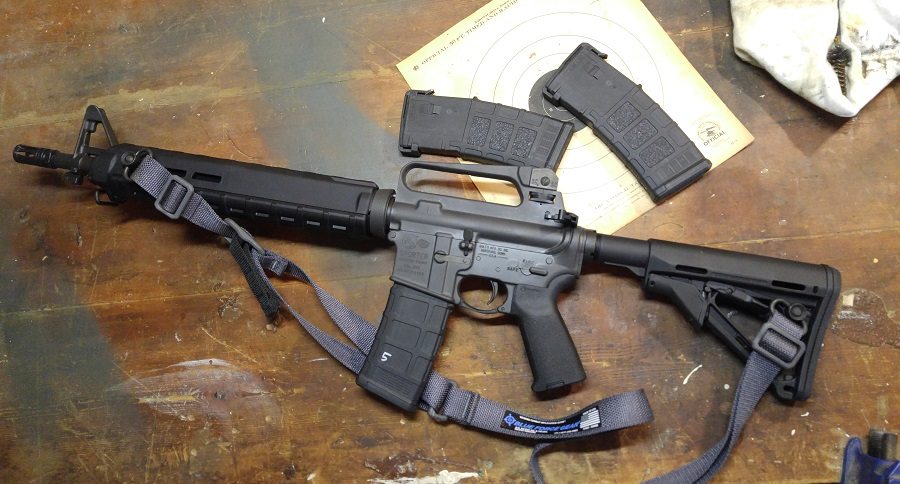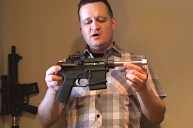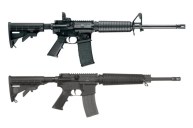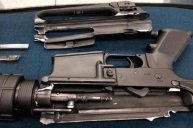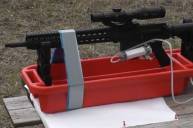Curious about building an AR-15? Here are a few expert tips that will save you time, money, and aggravation-and help you enjoy the process and end product more!
I'm not going to pull any punches: If you've ever thought about building an AR-15, the time to do it is now.
As I write this in 2017, the AR-15 market is in a beautiful rut of sorts. After a tumultuous eight or so past years of gun control threats looming on the horizon, combined with a booming firearms economy, the market has been flooded with AR-15-related commodities. Parts and accessories are (relatively) inexpensive and plentiful. Used quality parts are everywhere. So, why not start putting together that rifle you've always wanted? Trust me, building an AR-15 is easier than you think.
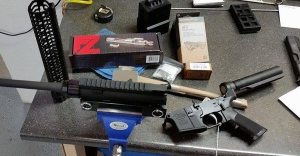
An AR-15 build on the bench. Photo courtesy of Furlong Custom Creations.
If you've never dived into the AR-15 world, you're in for a surprise. There is a dizzying array of nomenclature, acronyms (LPK, AFG, BCG, etc.), and options for your new firearm. So, where on earth do you start?
Before you even start spending, you have to start thinking (or, better yet, start learning).
Before you open that wallet...
Be honest with yourself and have a goal.
What will you be doing with your AR-15? Self defense? Hunting? Sandpit plinking? Competition? Keeping it in the safe to dig out and brag when you have friends over?
All of these are fine and dandy reasons to own an AR. Just have a clear goal in mind regarding the purpose. Parts exist to equip your AR-15 to fulfill practically any mission you can dream up, so you can tailor the build to your needs.
Have a budget, but don't go cheap.
My first time building an AR-15 years ago, I didn't have a clear idea of what I wanted my AR to do, so I spent TONS of money trying different accessories until I found my "Goldilocks" configuration. If I'd set a budget at the beginning and been clear with my goals, I would have saved a lot of extra money that could have been spent on training, ammunition, magazines - you get the picture. Do your research, shop around, and choose wisely. There are lots of options at lots of price points. Get the best you can afford.
Ask people who are more knowledgeable than you.
Find a local builder who has a good reputation, and talk to him/her face to face. Present your plans. Ask questions. Pay them for their time by sourcing parts from them for your AR-15 build. Keep your local shop in business!
Stay away from Internet forums. While there is a bunch of knowledge online, many frequenters of these forums look down on new guys and their questions, forgetting that they were once in the exact same spot as you are. There are also too many self-proclaimed "experts" who will give you crummy advice.
Instead, join a local AR-15 geared Facebook group. I can guarantee there's one for your area. Local guys who stay on local forums are much more likely to be humble and helpful. They're a great source of used parts to help you stay in your budget, too.
Consider buying a fully assembled upper receiver.
The upper receiver requires specialized tools to assemble properly. If you buy a fully assembled upper, it's likely to come with a properly matched barrel and gas tube length. Lots of companies offer completed uppers, and upper receivers can legally ship to your door without doing a 4473 background check. I personally like Windham Weaponry uppers: they're of superb quality but don't break the bank. You can also peruse Brownells for a great selection of completed uppers.
If budget allows, you could also consider two assembled upper receivers, each with a different intended purpose (e.g. one 16" barreled upper with a railed hand guard and a light for home defense, and another upper with a long match barrel and free-float hand guard for varmint or target use).
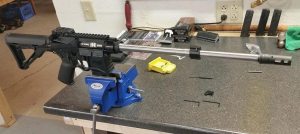
Photo courtesy of Furlong Custom Creations.
Expert Advice
To expand on my knowledge base, I contacted a local builder with an unerringly superb reputation to ask him what advice he'd give to a person who's building an AR-15 for the first time. Jeff Furlong of Furlong's Custom Creations in Raymond, Maine is extremely knowledgeable and very easy to speak to when it comes to AR-15 builds, as well as any other number of firearms customizations. When I was looking for a new barrel for an old Colt AR-15A2 HBAR, Jeff sourced the parts I needed and did a stellar job truing and building the new upper assembly, so I trust his advice and experience implicitly. Here's what he had to say to a few questions I asked him.
WOS: What should a new builder do before building an AR-15 for the first time?
Jeff: "The number one priority for any builder, first timer or seasoned professional, is be able to decide what the AR will be used for. To me it makes a big difference in the end product to know exactly what the intended use will be. Range blasters, home/self defense, match/target, or hunting. This information is vital in making sure you build it with the correct components.
Once you have determined that, get some education. YouTube tends to be the popular way to go, but there are often mixed results. Tap your local resources, ask questions, do research and learn as much as you can about what you're going to be doing, and what tools and fixtures you will need.
Tools! Having the correct tools for the job is priceless. Simple things like roll pin starters can really make a big difference in build time, frustration factor, and overall build quality."
WOS: What are the most common mistakes you see on new AR builds?
Jeff: "Common mistakes I see in my shop are: Loose gas blocks, loose/over torqued barrel nuts, loose castle nuts, loose/stripped grip screws, mashed detent springs, missing detents, wrong parts combinations (gas tube length, buffer weight, BCG (Bolt Carrier Group) weight/configuration, barrel length, wrong barrel twist rate for application)"
WOS: Any other tips or advice for the first build?
Jeff: "Set a solid end goal for the project. Build what YOU want, not what your buddies or the forum tell you. Build towards that goal. If you want a sub-MOA match rifle, don't let some one talk you into doing a 10.5" pistol build; in the end, you will probably not be satisfied.
Don't let cost steer your build. I know that sounds like a great sales pitch, however there is some reasoning behind that. AR parts are cheap in the grand scheme of hobbies. Some are over priced, and some are too cheaply made to be a bargain. That is where the homework comes in. 'Budget' builds - just to "try out" an AR-15 build - usually end up on the used rack at some giant box stores gun department, and at a significant loss. Do it right, do it once, and be really happy with your end result."
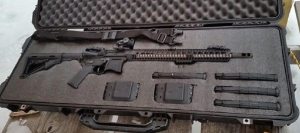
Photo courtesy of Furlong Custom Creations
Wrapping it up
I know you're excited to jump head-first into building your first example of America's rifle, but be sure to take the time to do your research. The inexpensive online kit deals may seem tempting, but in the long run you'll be happier with the end product if you do your homework ahead of time and make sure you're building an AR-15 for your intended purpose with the best parts you can afford. Good luck, don't be afraid to ask questions, and happy building!
